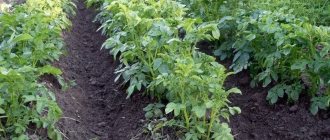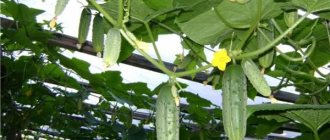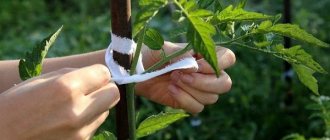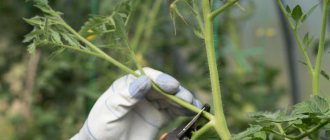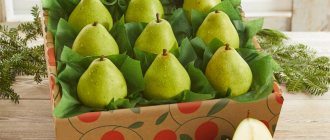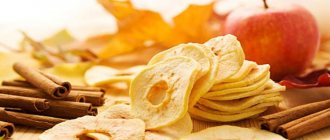How to tell if an onion is ripe
Onions fully ripen in the first half of August, but the timing varies slightly depending on the region and climatic conditions. For long-term storage of crops, it is important to prevent vegetables from overripening or digging them up prematurely.
The approximate time for harvesting vegetables is about 80 days from the date of planting, if the variety was not planted early.
If the husk has not yet fully formed , the bulbs will quickly begin to rot even at the right temperature and humidity. On late-harvested vegetables, dry scales practically do not stick, they quickly fall off, and roots sprout. Overripe specimens become excessively watery and lose their sharpness and richness of taste. It is better to use such onions immediately or use them for preservation, but do not leave them for storage.
Signs
The main sign of ripe vegetables is dried and yellowed tops . She weakens and completely sinks to the ground. By the time of harvest, the bulbs are maximally saturated with useful substances.
Reference! Focusing on yellowed and fallen tops is not always correct: during rainy and cool summers, the feathers do not fall down.
Reliable external signs of bulb ripening:
- thinning and drying neck;
- Some of the dry scales peeking out from the ground do not peel off and look dry.
If the tops have not turned yellow before the scheduled harvest, they are not cut off immediately . The bulbs are left for 15–20 days under a canopy: during this time the feathers dry out and all the nutrients go into the turnips.
It can be useful:
Ultra-early and cold-resistant salad type of onion “Ellan”
One of the most delicious onion varieties: Yalta
Onions with good frost tolerance "Chalcedony"
How to properly harvest onions
A dry, sunny day is chosen for harvesting . Watering is stopped after 10–14 days to increase the shelf life of vegetables. During prolonged rains, cover the area with waterproof material so that the onions do not dry out for a long time.
By the way! On peaty or sandy soil, turnips are easily pulled out, but on dense loamy soil they often remain without bottoms and quickly rot.
Onions are collected in the morning, pulled out of the ground, and left on the garden bed in even rows for pre-drying . In the evening, they are transferred to a barn or other room with good ventilation for 2-3 days. After this, the remaining soil is removed from the vegetables, and the root part is cut off to the very bottom.
High-quality drying is the key to long-term storage . If the bulbs are left wet, mold will quickly spread to them and cause rot.
Preparation and trimming
After collecting from the garden and drying, all vegetables are carefully inspected and sorted . Affected specimens are thrown away or consumed first. They are not suitable for storage.
How to properly trim an onion
For winter storage, feathers are removed in such a way that the turnip husk is not damaged . If the tops are dry and stretch well, they are torn off by hand, leaving a stem no more than 5 cm long. If the bulb has a large, thick neck, about 8–10 cm is left at the base, but such specimens spoil the first. To store the crop in “braids”, the neck is left up to 15 cm.
Important! If onions are harvested for more than 3 months, the cut site is treated with lime paste. This will reduce the risk of rot or sprouting.
How to prune sets
The planting material is not consumed, but stored until the next season in order to grow full-fledged turnips. Harvesting and storing onion sets is somewhat different from usual; pruning also becomes more labor-intensive due to the size of the vegetables.
The feathers are cut off immediately after the seedlings are removed from the soil . The root part is not removed, but only cleaned of soil residues. The tops are cut 10 cm from the base. During pruning, culling is also carried out immediately, removing damaged specimens from the total mass.
When not to prune
Sometimes trimming onions is completely useless . So, some gardeners use dry tops for tying instead of rope. Rotten or damaged specimens are removed from the total harvest to prevent damage to the rest. The vegetables are first laid out in the open sun on the site for 10–12 hours.
How to dry properly
Drying turnips and sets prevents them from being damaged by rot . In dry weather, the harvest is laid out on open beds, plywood sheets or boards, and in rainy weather - in a well-ventilated room, on burlap or a layer of paper. Vegetables are kept in sunlight for 10–15 days.
Onions are also stored in braids if it is not possible to arrange them in layers . Hang it in dry, ventilated areas (in a barn, veranda, attic). After complete drying, the braids are tied again, removing damaged specimens.
When do you need to trim the top when not growing for feathers?
Initially, the sets need to be inspected, medium and small heads selected, especially if your goal is to grow not a feather, but the onion itself. After which you need to trim the tail without affecting the head itself. If you cut to the shoulders, you can cut off the seedling itself. The rudiments of the feathers will be damaged, and without a thick feather, a high-quality bulb will not be able to grow. Next, the procedure of hardening, disinfection and aging in a nutrient solution is carried out.
Winter seedlings are prepared for planting a little differently:
- Unsuitable seed material is rejected.
- Afterwards, the onions are sorted by size; in the future, they will be planted one by one: first large specimens, then slightly smaller ones, and then the smallest onions, as they will germinate faster.
- Winter sets are planted more densely than spring ones.
- Dry ends and roots are not cut off.
- Soaking and heating are also not necessary.
Important! Remember that if you trim the onion too much in advance, it may rot, especially if there are frequent rainy days in the region.
After this, subsequent pruning of the onion is done right before planting, using a sharp knife, pruning shears or scissors. If you carry out this process in advance, there is a risk of infection on the sections. In this case, you should not expect a good harvest.
Find out about which plants onions will grow well next to and which ones are not suitable for the neighborhood, and also after which crops you should plant onions.
Winter storage
The choice of location for onions is determined taking into account the capabilities and volume of the harvest. It is much easier for owners of private houses or garages to solve this problem than for apartment owners.
Main conditions:
- cleanliness of the room and selected containers;
- temperature - within 0°C;
- air humidity - 65-75%;
- regular ventilation and good ventilation.
It is allowed to store onions at a temperature of -2...-3°C, but without hesitation . In such conditions, vegetables are suitable for consumption for 8–10 months.
Where and how to store
It is convenient to keep onions in a cellar or basement . They do this in several ways:
- in bulk (one mound up to 3 m high on pallets made of boards or on shelves with holes for ventilation);
- in wooden boxes covered with bags or blankets;
- in nets and bags;
- in the form of bundles.
If the room has poor thermal insulation, then during severe frosts the crops are covered with blankets and straw. The main thing is that the material allows air to pass through.
At home
Apartments have much fewer conditions for storing crops. One of the storage options is the refrigerator, but in it the vegetables retain freshness and taste only for up to 1.5 months. The optimal place is the lower shelves or drawers for vegetables. The bulbs are not tied tightly in plastic bags, otherwise condensation will form. It is enough to place them in bulk or in paper bags.
Important! On the top shelves of the refrigerator, onions quickly rot and a specific smell appears.
On insulated balconies, where the temperature does not exceed +7°C and does not fall below 0°C, vegetables are placed in boxes or bowls . Do not place such containers next to potatoes: they actively release moisture, which leads to rapid spoilage of the crop.
Features of planting onions
Having figured out whether or not it is necessary to cut off the top of onion sets, it is worth learning about how to plant them correctly.
Features of planting onions
Treating onions with salt and potassium permanganate before planting
The planting site is usually prepared in the fall. The soil is carefully and deeply dug up, fertilized with manure, compost or chicken droppings at the rate of one and a half to two buckets of organic matter per square meter. In addition, superphosphate with potassium salts must be included in the proper volume of fertilizers. Onions, which have a particularly nice and large head, are usually obtained from areas where peas, zucchini, potatoes, tomatoes or pumpkins previously grew. After carrots, garlic and cucumbers, on the contrary, you shouldn’t count on a decent harvest.
Planting is usually done when spring arrives and warm weather sets in. It is very important that the earth warms up sufficiently, at least to +14 degrees. In central Russia, the optimal time for planting onion sets is the end of April-beginning of May.
Immediately before placing onions in the soil, the beds are spilled with a weak solution of potassium permanganate. You will no longer need to fertilize the soil throughout the growing season. You will only need to periodically water the onions and remove weeds.
The seedlings are planted in pre-prepared and loosened beds. This is done according to the scheme. It is very important to maintain a distance of 12 centimeters between the bulbs, and 25-28 centimeters between the beds. The planting depth of the set heads can vary from 14.5 to 5 centimeters. After planting, the soil needs to be mulched. Sawdust or straw are most often used as mulch. Alternatively, freshly planted seedlings can be covered with a dark film to prevent drying out.
Previously, so-called family onions were often planted. Currently it is not very popular.
This variety has relatively small bulbs, but if agricultural techniques are fully followed, a very decent harvest can be obtained. Heirloom onions are usually planted in early spring. Experts strongly recommend slightly trimming the bottom of the bulb, since a well-developed root system is especially important for the described species and its successful growth. Returning to the question of the need to cut off the tops of the onion, it should be noted that in the case of heirloom onions, this procedure is not so significant. The most important thing is to remove excess husks before planting, under which harmful bacteria may be hiding.
Onions are a fairly easy plant to grow. But in order for the harvest to be plentiful, the preparation of seed and planting the plant in open ground should be approached with maximum responsibility. And in order not to take risks, you should probably trim the tops. In the end, most gardeners continue to do just that and do not complain about the low yield of the crop they grow.
1 1 vote
Article rating
